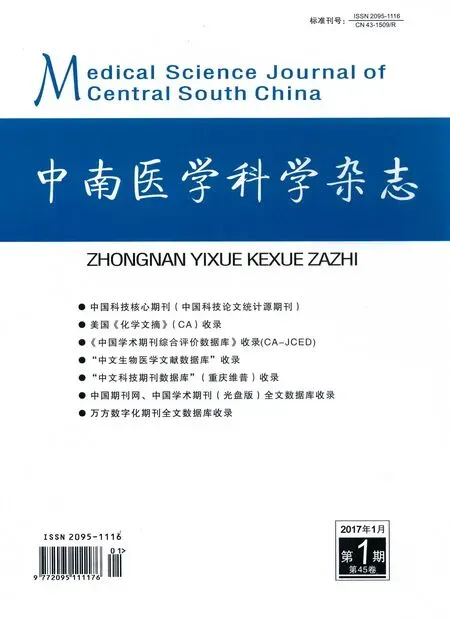[-2]proPSA及%p2PSA、PHI在前列腺癌诊断中的研究进展
2017-12-25,
,
(南华大学附属第二医院泌尿外科,湖南 衡阳 421001)
·小专论·
[-2]proPSA及%p2PSA、PHI在前列腺癌诊断中的研究进展
刘冰,罗志刚*
(南华大学附属第二医院泌尿外科,湖南 衡阳 421001)
前列腺特异性抗原(PSA)作为前列腺癌(PCa)应用最广泛的诊断标记物,在提高早期诊断率、减少死亡率的同时,也暴露出低特异性、低敏感性的缺点。前2肽前列腺特异性抗原([-2]proPSA/p2PSA)是PSA前体的一种同源异构体,具有不被水解的稳定性、肿瘤特异性、组织区域特异性的特点,[-2]proPSA百分比值(%p2PSA)和前列腺健康指数(PHI)是[-2]proPSA的两个衍生物。目前越来越多的研究表明:与传统的PSA等相比,[-2]proPSA及%p2PSA、PHI能显著提高PCa的诊断特异性,减少不必要的前列腺穿刺活检,并且在肿瘤恶性度预测及低风险、局限性的PCa患者的主动监测中均显示出良好的应用价值。本文就[-2]proPSA及%p2PSA、PHI在PCa临床诊断的研究进展进行综述。
前列腺特异性抗原; 前列腺癌; 穿刺活检
前列腺癌(Prostate cancer,PCa)是美国男性发病率最高的恶性实体肿瘤,也是美国因肿瘤致死第二大病因[1]。我国PCa的发病率虽低于欧美发达国家和地区,但近年来一直处于显著上升的趋势,且增长更为迅速,特别是在经济发达地区。根治性前列腺切除术是临床上治愈T1期、T2期PCa的首选治疗方式,因此,提高PCa的早期诊断率对其预后至关重要。前列腺特异性抗原(prostate-specific antigen,PSA)作为PCa诊断标记物,临床上被广泛应用于PCa的筛查,显著提高了PCa的诊断率,减少了死亡率。但其弊端也逐渐显露:灵敏度偏低,在总前列腺特异性抗原(total PSA,tPSA)处于正常范围(<4.0 ng/mL),前列腺癌穿刺阳性率为15.2%[2];其次、特异性偏低,在tPSA的诊断灰区(4~10 ng/mL),前列腺穿刺及反复穿刺阴性率为78%和90%[3],这意味在血清tPSA处于4~10 ng/mL的人群中,78%的人群PSA水平因良性前列腺增生、炎症、按摩等原因而升高,却接受了不必要的前列腺穿刺活检,其中再次或多次行穿刺的阴性率高达90%。最后,预测肿瘤病理分级的精确度不足。据报道,tPSA在<10 ng/mL时,难以鉴别有临床意义的PCa(病理GS评分>7)和惰性肿瘤(局限性、低风险、分化好)[4]。因此,临床上急需找到一种新的、准确度更高的PCa诊断的标记物。

1 [-2]proPSA及%p2PSA、PHI在PCa中的诊断效能
1.1血清%p2PSA在PCa诊断中的价值近年来,[-2]proPSA、%p2PSA在PCa的临床应用的研究被相继报道。Sokoll等[5]研究表明,PCa患者血清中,游离PSA百分比值(percentage of free PSA,%fPSA)偏低,而[-2]proPSA和%p2PSA较高;当tPSA值为2.0~10.0 ng/mL时,[-2]proPSA和%p2PSA与PCa相关性明显,%p2PSA与%fPSA的AUC分别为0.73、0.53。Guazzoni等[6]的研究证实上述结论,并进一步对实验结果进行单变量精度分析后表明,%p2PSA是PCa诊断效能最高的预测指标(其AUC为0.76),其次为患者年龄(0.63)、PSA密度(0.61)、%fPSA(0.58)、tPSA(0.53)。Stephan等[7]报道,把诊断灵敏度设为90%,%p2PSA、%fPSA、tPSA和患者年龄4个指标的联合检测的AUC(0.84)最高,较单独检测tPSA、%fPSA和%p2PSA有显著升高,且诊断特异性达到了53.1%。Rhodes等[8]研究表明:[-2]proPSA值随患者年龄增长、前列腺体积增大而逐渐增加;[-2]proPSA增幅较大的人群比增幅无明显变化的人群患PCa的几率更大(+8.1%/y vs.+3.5%/y)。以上研究均表明,和tPSA及%fPSA、PSA密度、患者年龄等相比,[-2]proPSA及%p2PSA具有更高的诊断灵敏度、特异度。
1.2血清PHI在PCa诊断中的价值最新研究发现,[-2]proPSA和其他指标的联合应用,能更准确地鉴别诊断前列腺良恶性疾病。于是Beckman公司提出了前列腺健康指数(Prostate Health Index,PHI)的概念,Le等[9]实验表明,PHI的预测PCa能力最强 (AUC:0.77),其次为%p2PSA、%fPSA;设定灵敏度为88.5%,PHI及%p2PSA的特异性较%fPSA及tPSA均有显著的提高,此外、tPSA在2.5~10 ng/mL范围内,缺乏敏感性和特异性(AUC:0.50)。Guazzoni等[6]研究表明,PHI和%p2PSA均是预测PCa精确度最高的指标。联合检测tPSA、fPSA、患者年龄、前列腺体积能够使PHI和%p2PSA的诊断AUC分别提高了11%和10%。PHI可指导前列腺穿刺活检,Lazzeri等[10]报道,取PHI正常参考值(或临界值)为28.8,能够避免52.25%的穿刺活检。Loeb等[11]研究表明,PHI可以提高tPSA及%fPSA预测前列腺活检时PCa发生率及恶性度的准确性。Ito等[12]报道:当tPSA值为2~10 ng/mL,PHI的灵敏度设为95%,能够避免患者中29%的不必要穿刺。Ng等[13]在另一项回顾性研究表明:在灵敏度设为90%时,PHI是预测前列腺活检结果的最佳指标;应用PHI可以减少(45.2%)患者不必要的穿刺活检。
2 [-2]proPSA及%p2PSA、PHI在PCa的病理分级中的作用
目前,临床上采用Gleason评分(GS评分)和肿瘤分期来评估PCa的恶性程度(侵袭性),但这些指标均受到观测者不同程度主观判断的影响。因此,诊断标记物能否具有预测肿瘤侵袭性成为研究者最为关心的问题。Sokoll等[5]对PCa可疑患者的血清样本进行前瞻性研究,来探讨[-2]proPSA与PCa的侵袭性的关系。研究表明,tPSA处于较低水平(2~4 ng/mL),%p2PSA与PCa的侵袭性呈明显正相关。Catalona等[14]研究发现,PHI与GS评分具有相关性,GS评分≥ 4+3的PCa,其AUC为0.724。此外、PHI>55.0的男性PCa阳性穿刺率为54%,而PHI<25.0的男性,阳性穿刺率只有26%。Stephan等[15]进一步研究表明:PHI>55.0的患者肿瘤,GS评分高于7分的风险是PHI<25.0患者的1.6倍多。Guazzoni等[6]发现,术后病理分期为pT3,、病理分级GS评分≥7、GS评分升级(术后病检GS评分较术前穿刺活检评分高)的患者中,术前%p2PSA和PHI均显著升高,提示血清%p2PSA及PHI能够更好地预测PCa的侵袭性及肿瘤分期。Heidegger等[16]报道,与CS评分≤7的患者相比,GS评分≥8的患者血清[-2]proPSA水平在3年前就有了显著差别(p<0.001),且病理分期pT3a或更高的肿瘤患者[-2]proPSA水平同样明显高于pT2c及以下分期患者。研究表明:[-2]proPSA取22.5 pg/mL水平为临界值,能够更加准确的鉴别诊断前列腺局限性和已扩散的肿瘤。
3 [-2]proPSA、%p2PSA和PHI在PCa患者的主动监测中的作用
由于PSA广泛应用于PCa的初筛,可发现低风险、无进展的(小体积或分化较好的局限性)肿瘤。为了减少这类患者后续过度医疗,主动监测(active surveillance,AS)这一概念被学术界提出并达成共识。即对低风险、无进展的PCa患者,不即刻实施手术治疗而积极监测、严密随访的方式,在肿瘤达到进展阈值时再给予治疗。参与AS的患者每隔1~2年就要接受前列腺穿刺,并承受疼痛、出血、急性感染等并发症。在给病人带来痛苦的同时,增加了患者的经济负担。此外,由于肿瘤多中心生长及肿瘤内异质性等原因,临床上容易造成PCa假阴性率的病理结果。若[-2]proPSA及PHI能够用于PCa的主动监测,这样可以减少患者前列腺穿刺的频率,更有利于增加患者对主动监测的依从性。
最新研究表明,[-2]proPSA、%p2PSA及PHI在PCa临床AS中显示了良好的潜能。Makarov等[17]通过对[-2]proPSA监测与前列腺活检病理报告进行相关性分析,研究发现:%p2PSA越高的患者,恶性度越高。Isharwal等[18]研究表明,PHI在预后差的患者中显著升高,如果在AS中联合PHI、%p2PSA及活检组织中DNA含量的测定,可以提高70%的PCa恶性度的预测精确度。Hirama等[19]报道,[-2]proPSA基线水平及相关指数与患者病理GS评分升级的风险密切相关;多因素逻辑回归分析表明,%p2PSA和PHI联合检测是唯一在AS期间能够独立预测1年后病理GS评分升级的标记物。以上实验结论仍需要进一步大样本的研究所证实。
4 展 望
PCa是严重威胁男性健康的重要恶性肿瘤之一,死亡率也较高,故寻找早期诊断PCa的方法非常重要。现有的研究表明[-2]proPSA、%p2PSA及PHI作为新的诊断标记物比传统的tPSA、fPSA和%fPSA等在鉴别诊断前列腺良恶性疾病的精确度更高,不但有助于PCa的早期发现、早期诊断、早期治疗,而且能够降低不必要的前列腺穿刺活检率。更重要的是,%p2PSA与PHI水平的上升还与PCa侵袭性密切相关,它与GS评分结合在术前病理结果预测、预后判断均有重要意义。此外,PHI和%p2PSA对低风险、无进展的PCa患者的主动监测中也凸显了良好的价值,在肿瘤的术后判断其复发及转移有较好的应用潜能。
但目前的研究也存在一些不足,回顾性研究多,样本量少,研究对象存在种族(研究人群多为白种人)、年龄、家族史等差异,且大多都在tPSA<10 ng/mL范围内进行等,使得现有研究的结果尚具有一定的局限性,因此,尚需作进一步的探讨,为[-2]proPSA及%p2PSA、PHI作为前列腺癌的诊断标记物提供更多的依据。
[1] Siegel R,Naishadham D,Jemal A.Cancer statistics,2013[J].CA Cancer J Clin,2013,63(1):11-30.
[2] Birney E,Stamatoyannopoulos JA,Dutta A,et al.Identification and analysis of functional elements in 1% of the human genome by the ENCODE pilot project[J].Nature,2007,447(7146):799-816.
[3] Tsang JC,Lo YM.Circulating nucleic acids in plasma/serum[J].Pathology,2007,39(2):197-207.
[4] Hori S,Blanchet JS,McLoughlin J.From prostate-specific antigen (PSA) to precursor PSA (proPSA) isoforms:a review of the emerging role of proPSAs in the detection and management of early prostate cancer[J].BJU Int,2013,112(6):717-728.
[5] Sokoll LJ,Chan DW,Mikolajczyk SD,et al.Proenzyme psa for the early detection of prostate cancer in the 2.5-4.0 ng/mL total psa range:preliminary analysis[J].Urology,2003,61(2):274-276.
[6] Guazzoni G,Nava L,Lazzeri M,et al.Prostate-specific antigen (PSA) isoform p2PSA significantly improves the prediction of prostate cancer at initial extended prostate biopsies in patients with total PSA between 2.0 and 10 ng/mL:results of a prospective study in a clinical setting[J].Eur Urol,2011,60(2):214-222.
[7] Stephan C,Kahrs AM,Cammann H,et al.A [-2]proPSA-based artificial neural network significantly improves differentiation between prostate cancer and benign prostatic diseases[J].Prostate,2009,69(2):198-207.
[8] Rhodes T,Jacobson DJ,McGree ME,et al.Longitudinal changes of benign prostate-specific antigen and [-2]proprostate-specific antigen in seven years in a community-based sample of men[J].Urology,2012,79(3):655-661.
[9] Le BV,Griffin CR,Loeb S,et al.[-2]Proenzyme prostate specific antigen is more accurate than total and free prostate specific antigen in differentiating prostate cancer from benign disease in a prospective prostate cancer screening study[J].J Urol,2010,183(4):1355-1359.
[10] Lazzeri M,Briganti A,Scattoni V,et al.Serum index test %[-2]proPSA and Prostate Health Index are more accurate than prostate specific antigen and %fPSA in predicting a positive repeat prostate biopsy[J].J Urol,2012,188(4):1137-1143.
[11] Loeb S.Prostate Health Index (PHI):golden bullet or just another prostate cancer marker[J].Eur Urol,2013,63(6):995-996;discussion 996-997.
[12] Ito K,Miyakubo M,Sekine Y,et al.Diagnostic significance of [-2]pro-PSA and prostate dimension-adjusted PSA-related indices in men with total PSA in the 2.0~10.0 ng/mL range[J].World J Urol,2013,31(2):305-311.
[13] Ng CF,Chiu PK,Lam NY,et al.The Prostate Health Index in predicting initial prostate biopsy outcomes in Asian men with prostate-specific antigen levels of 4-10 ng/mL[J].Int Urol Nephrol,2014,46(4):711-717.
[14] Catalona WJ,Partin AW,Sanda MG,et al.A multicenter study of [-2]pro-prostate specific antigen combined with prostate specific antigen and free prostate specific antigen for prostate cancer detection in the 2.0 to 10.0 ng/mL prostate specific antigen range[J].J Urol,2011,185(5):1650-1655.
[15] Stephan C,Vincendeau S,Houlgatte A,et al.Multicenter evaluation of [-2]proprostate-specific antigen and the prostate health index for detecting prostate cancer[J].Clin Chem,2013,59(1):306-314.
[16] Heidegger I,Klocker H,Steiner E,et al.[-2]proPSA is an early marker for prostate cancer aggressiveness[J].Prostate Cancer Prostatic Dis,2014,17(1):70-74.
[17] Makarov DV,Isharwal S,Sokoll LJ,et al.Pro-prostate-specific antigen measurements in serum and tissue are associated with treatment necessity among men enrolled in expectant management for prostate cancer[J].Clin Cancer Res,2009,15(23):7316-7321.
[18] Isharwal S,Makarov DV,Sokoll LJ,et al.ProPSA and diagnostic biopsy tissue DNA content combination improves accuracy to predict need for prostate cancer treatment among men enrolled in an active surveillance program[J].Urology,2011,77(3):763.e1-6.
[19] Hirama H,Sugimoto M,Ito K,et al.The impact of baseline [-2]proPSA-related indices on the prediction of pathological reclassification at 1 year during active surveillance for low-risk prostate cancer:the Japanese multicenter study cohort[J].J Cancer Res Clin Oncol,2014,140(2):257-263.
10.15972/j.cnki.43-1509/r.2017.01.027
2016-10-10;
2016-12-30
*通讯作者,E-mail:706885399@qq.com.
R737.25
A
蒋湘莲)
